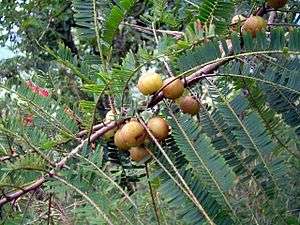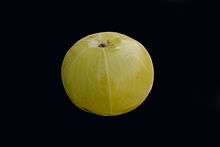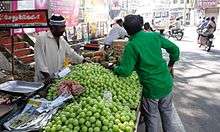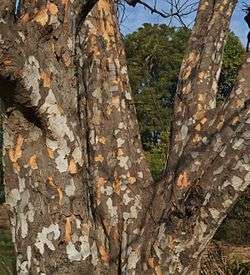Phyllanthus emblica
| Phyllanthus emblica | |
|---|---|
 | |
| Plant | |
 | |
| Fruit | |
| Scientific classification | |
| Kingdom: | Plantae |
| (unranked): | Angiosperms |
| (unranked): | Eudicots |
| (unranked): | Rosids |
| Order: | Malpighiales |
| Family: | Phyllanthaceae |
| Tribe: | Phyllantheae |
| Subtribe: | Flueggeinae |
| Genus: | Phyllanthus |
| Species: | P. emblica |
| Binomial name | |
| Phyllanthus emblica L.[1] | |
| Synonyms[2] | |
| |
Phyllanthus emblica, also known as emblic,[1][3] emblic myrobalan,[1] myrobalan,[3] Indian gooseberry,[1][3] Malacca tree,[3] or amla[3] from Sanskrit amalika is a deciduous tree of the family Phyllanthaceae. It is known for its edible fruit of the same name.
Plant morphology and harvesting
The tree is small to medium in size, reaching 1–8 m (3 ft 3 in–26 ft 3 in) in height. The branchlets aren't glabrous or finely pubescent, 10–20 cm (3.9–7.9 in) long, usually deciduous; the leaves are simple, subsessile and closely set along branchlets, light green, resembling pinnate leaves. The flowers are greenish-yellow. The fruit is nearly spherical, light greenish yellow, quite smooth and hard on appearance, with six vertical stripes or furrows.
Ripening in autumn, the berries are harvested by hand after climbing to upper branches bearing the fruits. The taste of Indian emblic is sour, bitter and astringent, and it is quite fibrous. In India, it is common to eat emblic steeped in salt water and red chilli powder to make the sour fruits palatable.
Cultural and religious significance
_fruit_with_young_leaves_%26_flower_buds_at_Jayanti%2C_Duars%2C_West_Bengal_W_Picture_045.jpg)
The tree is considered sacred by Hindus as God Vishnu is believed to dwell in it. The tree is worshiped on Amalaka Ekadashi.
In other Hindu beliefs, Amla is said to have originated from the drops of Amrit which spilled on earth accidentally, because of the fight of Gods and Demons after ksheera sagar manthan. And hence also this religious belief makes claims that it almost cures every disease and is also good in extending the longevity of life.
In the Sanskrit Buddhist tradition half an amalaka fruit was the final gift to the Buddhist sangha by the great Indian emperor Ashoka. This is illustrated in the Ashokavadana in the following verses:
"A great donor, the lord of men, the eminent Maurya Ashoka, has gone from being lord of Jambudvipa [the continent] to being lord of half a myrobalan." (Strong, 1983, p. 99)[4] This deed became so famous that a stupa was created to mark the place of the event in modern-day Patna and was known as the Amalaka stupa.
According to Hindu tradition, Adi Shankara of Kerala composed and recited the Kanakadhara stotram in praise of Mahalakshmi to make a poor Brahmin lady get wealth, in return for a single amla presented to him as bhiksha on an auspicious dwadashi day. Contemporary poet/philosopher Ravi Teja Yelamanchili wrote a book titled Amalaki. The book is based on Advaita Vedanta of Sri Adi Shankaracharya.
According to a Tamil legend, Avvaiyar (Tamil: ஔவையார்), a female poet, ethicist and political activist of the Sangam period was gifted with one amla by King Athiyaman to give her long life.
In Theravada Buddhism, this plant is said to have been used as the tree for achieving enlightenment, or Bodhi by twenty first Lord Buddha called "Pussa - ඵුස්ස".
Traditional uses

Traditional medicine
In traditional Indian medicine, dried and fresh fruits of the plant are used. All parts of the plant are used in various Ayurvedic/Unani medicine (Jawarish amla) herbal preparations, including the fruit, seed, leaves, root, bark and flowers.[5] According to Ayurveda, amla fruit is sour (amla) and astringent (kashaya) in taste (rasa), with sweet (madhura), bitter (tikta) and pungent (katu) secondary tastes (anurasas).[5] Its qualities (gunas) are light (laghu) and dry (ruksha), the postdigestive effect (vipaka) is sweet (madhura) and its energy (virya) is cooling (shita).[6]
According to Ayurveda, amla balances all three doshas. While amla is unusual in that it contains five out of the six tastes recognized by Ayurveda, it is most important to recognize the effects of the "virya", or potency, and "vipaka", or post-digestive effect. Considered in this light, amla is particularly helpful in reducing pitta because of its cooling energy.[5] It also balances both Pitta and vata by virtue of its sweet taste. The kapha is balanced primarily due to its drying action. It may be used as a rasayana (rejuvenative) to promote longevity, and traditionally to enhance digestion (dipanapachana), treat constipation (anuloma), reduce fever (jvaraghna), purify the blood (raktaprasadana), reduce cough (kasahara), alleviate asthma (svasahara), strengthen the heart (hrdaya), benefit the eyes (chakshushya), stimulate hair growth (romasanjana), enliven the body (jivaniya), and enhance intellect (medhya).[5][6]
In Ayurvedic polyherbal formulations, Indian gooseberry is a common constituent, and most notably is the primary ingredient in an ancient herbal rasayana called Chyawanprash.[7] This formula, which contains 43 herbal ingredients as well as clarified butter, sesame oil, sugar cane juice, and honey, was first mentioned in the Charaka Samhita as a premier rejuvenative compound.[8][9]
In Chinese traditional therapy, this fruit is called yuganzi (余甘子), which is used to treat throat inflammation.
Culinary use
Maharashtra is one of the largest producers and suppliers of Indian gooseberries. In this region the fruit is commonly pickled with salt, oil, and spices. The amla fruit is eaten raw or cooked into various dishes. In Andhra Pradesh, tender varieties are used to prepare dal (a lentil preparation), and amle ka murabbah, a sweet dish made by soaking the berries in sugar syrup until they are candied. It is traditionally consumed after meals.
In the Batak area of Sumatra, Indonesia, the inner bark is used to impart an astringent, bitter taste to the broth of a traditional fish soup known as holat.[10]
Other uses
Popularly used in inks, shampoos and hair oils, the high tannin content of Indian gooseberry fruit serves as a mordant for fixing dyes in fabrics.[5] Amla shampoos and hair oil are traditionally believed to nourish the hair and scalp and prevent premature grey hair.[11]
In Kerala, well beds are lined with Emblica timber (നെല്ലിപ്പലക) to get clean and sweet water for drinking and cooking.
Pharmacological research
In vitro (on cells)
Indian gooseberry has undergone preliminary research, demonstrating in vitro antiviral and antimicrobial properties.[12] There is preliminary evidence in vitro that its extracts induce apoptosis and modify gene expression in osteoclasts involved in rheumatoid arthritis and osteoporosis.[13] It may prove to have potential activity against some cancers.[14]
In vivo (in animals)
One recent animal study found treatment with E. officinalis reduced severity of acute pancreatitis (induced by L-arginine in rats). It also promoted the spontaneous repair and regeneration process of the rat pancreas occurring after an acute attack.[15]
Experimental preparations of leaves, bark or fruit have shown potential efficacy against laboratory models of disease, such as for inflammation, cancer, age-related renal disease, and diabetes.[16][17][18]
Emblica officinalis tea may ameliorate diabetic neuropathy due to aldose reductase inhibition.[19][20][21]
In rats it significantly reduced blood glucose, food intake, water intake and urine output in diabetic rats compared with the non‐ diabetic control group.[22]
Another recent study with alloxan-induced diabetic rats given an aqueous amla fruit extract has shown significant decrease of the blood glucose, as well as triglyceridemic levels and an improvement of the liver function caused by a normalization of the liver-specific enzyme alanine transaminase activity.[23]
Clinical studies
A human pilot study demonstrated a reduction of blood cholesterol levels in both normal and hypercholesterolemic men with treatment.[24]
Chemical constituents
Although these fruits are reputed to contain high amounts of ascorbic acid (vitamin C), up to 445 mg per 100 g,[25] the specific contents are disputed, and the overall antioxidant strength of amla may derive instead from its high density of ellagitannins[7] such as emblicanin A (37%), emblicanin B (33%), punigluconin (12%) and pedunculagin (14%).[26] It also contains punicafolin and phyllanemblinin A, phyllanemblin other polyphenols: flavonoids, kaempferol, ellagic acid and gallic acid.[7][27]
Vernacular names
Names for this plant in various languages include:
Lozü in Ao languages
halïlaj or ihlïlaj (اهليلج هليلج) in Arabic
amlakhi in Assamese
balakka in Batak language, an Indonesian language
amloki (আমলকী) in Bengali
Amlai (आमलाइ) in Bodo language
anmole (庵摩勒) in Chinese
ambare (अमबरे) in Garo language
āmla (આમળાં) in Gujarati
ānvalā (आँवला) in Hindi
Kantout Prei (កន្ទួតព្រៃ) in Khmer
Bettada nellikaayi ಬೆಟ್ಟದ ನೆಲ್ಲಿಕಾಯಿ (ನೆಲ್ಲಿ / ನೆಲ್ಲಿಕಾಯಿ) in Kannada
sohmylleng in Khasi
āvāḷo (आवाळो) in Konkani
mak kham bom in Lao
melaka (ملاك) in Malay, A state in Malaysia, Malacca was named after this tree.
nelli (നെല്ലി) in Malayalam
heikru in Manipuri
āvaḷā (आवळा) (or awla) in Marathi
sunhlu in Mizo
zee phyu thee (ဆီးၿဖဴသီး) in Myanmar
amalā (अमला) in Nepali
anlaa (ଅଁଳା) in Oriya
Suaklu in Paite
Aula (ਔਲਾ) in Punjabi
amalika (अमलिक) in Sanskrit
Dhatric (धात्रिक) in Sanskrit, Maithili
nelli (නෙල්ලි) in Sinhala
Nelli (நெல்லி - Root Word) or Nellikkāy (நெல்லிக்காய்) or Nellikani (நெல்லிக்கனி) in Tamil
aavnlaa (amla or ambla or awla) in Urdu
usiri kaay (ఉసిరి కాయ) in Telugu
ma kham pom (มะขามป้อม) in Thai
skyu ru ra (སྐྱུ་རུ་ར་) in Tibetan
Amla (آملہ) in Urdu
Gallery
_new_leaves_at_Jayanti%2C_Duars%2C_West_Bengal_W_Picture_039.jpg)
New leaves _at_Jayanti%2C_Duars%2C_West_Bengal_W_Picture_045.jpg)
Flowering twigs _trunk_at_Jayanti%2C_Duars%2C_West_Bengal_W_Picture_041.jpg)
Tree trunk 
Bark of the Indian goosebery
See also
| Wikimedia Commons has media related to Phyllanthus emblica. |
- Emblicanin (antioxidant)
- Triphala, an Ayurvedic mixture containing Amla
References
- 1 2 3 4 "Phyllanthus emblica information from NPGS/GRIN". US Department of Agriculture. Retrieved 2008-03-06.
- ↑ "The Plant List: A Working List of All Plant Species". Retrieved 14 July 2014.
- 1 2 3 4 5 Lim, T.K. (2012). "Phyllanthus emblica". Edible Medicinal And Non-Medicinal Plants. Springer Netherlands. pp. 258–296.
- ↑ Strong, J. S. (1983) The Legend of King Ashoka, New York: Princeton University Press
- 1 2 3 4 5 Caldecott T. Amalaki
- 1 2 National R&D Facility for Rasayana - Amalaki
- 1 2 3 Dharmananda S. Emblic Myrobalans: Amla, Institute of Traditional Medicine
- ↑ Samhita C. Ed., translation by the Shree Gulabkunverba Society, Volume 4. Chikitsa Sthana, Jamnagar, India: 1949
- ↑ Indian Ministry of Health and Family Planning. The Ayurvedic Formulary of India. Part I. 1st ed. Delhi, 1978.
- ↑ de Clercq, F. S. A. (1909). Nieuw Plantkundig Woordenboek voor Nederlandsch Indië. Amsterdam: J. H. de Bussy. p. 303.
- ↑ Pole, Sebastian (2006). Ayurvedic Medicine: The Principles of Traditional Practice. Singing Dragon. pp. 126–127. ISBN 978-1-84819-113-6.
- ↑ Saeed S, Tariq P (Jan 2007). "Antibacterial activities of Emblica officinalis and Coriandrum sativum against Gram negative urinary pathogens". Pak J Pharm Sci. 20 (1): 32–5. PMID 17337425.
- ↑ Penolazzi, L.; Lampronti, I.; Borgatti, M.; Khan, M.; Zennaro, M.; Piva, R.; Gambari, R. (2008). "Induction of apoptosis of human primary osteoclasts treated with extracts from the medicinal plant Emblica officinalis". BMC Complementary and Alternative Medicine. 8: 59. doi:10.1186/1472-6882-8-59. PMC 2587459
 . PMID 18973662.
. PMID 18973662. - ↑ Ngamkitidechakul, C.; Jaijoy, K.; Hansakul, P.; Soonthornchareonnon, N.; Sireeratawong, S. (2010). "Antitumour effects of phyllanthus emblica L.: Induction of cancer cell apoptosis and Inhibition of in vivo tumour promotion and in vitro invasion of human cancer cells". Phytotherapy Research. 24 (9): 1405–1413. doi:10.1002/ptr.3127. PMID 20812284.
- ↑ Sidhu, S.; Pandhi, P.; Malhotra, S.; Vaiphei, K.; Khanduja, K. L. (2011). "Beneficial Effects ofEmblica officinalisinl-Arginine-Induced Acute Pancreatitis in Rats". Journal of Medicinal Food. 14 (1–2): 147–155. doi:10.1089/jmf.2010.1108. PMID 21138365.
- ↑ Ganju L, Karan D, Chanda S, Srivastava KK, Sawhney RC, Selvamurthy W (Sep 2003). "Immunomodulatory effects of agents of plant origin". Biomed Pharmacother. 57 (7): 296–300. doi:10.1016/S0753-3322(03)00095-7. PMID 14499177.
- ↑ Yokozawa T, Kim HY, Kim HJ, et al. (Sep 2007). "Amla (Emblica officinalis Gaertn.) attenuates age-related renal dysfunction by oxidative stress". J Agric Food Chem. 55 (19): 7744–52. doi:10.1021/jf072105s. PMID 17715896.
- ↑ Rao TP, Sakaguchi N, Juneja LR, Wada E, Yokozawa T (2005). "Amla (Emblica officinalis Gaertn.) extracts reduce oxidative stress in streptozotocin-induced diabetic rats". J Med Food. 8 (3): 362–8. doi:10.1089/jmf.2005.8.362. PMID 16176148.
- ↑ Mizisin, AP1; Calcutt, NA; DiStefano, PS; Acheson, A; Longo, FM (1997). "Aldose reductase inhibition increases CNTF-like bioactivity and protein in sciatic nerves from galactose-fed and normal rats.". Diabetes. 46 (4): 647–52. doi:10.2337/diab.46.4.647. PMID 9075806.
- ↑ Suryanarayana, P; Kumar, PA; Saraswat, M; Petrash, JM; Reddy, GB (2004). "Inhibition of aldose reductase by tannoid principles of Emblica officinalis: implications for the prevention of sugar cataract.". Molecular Vision. 10: 148–54. PMID 15031705.
- ↑ Puppala, M; Ponder, J; Suryanarayana, P; Reddy, GB; Petrash, JM; LaBarbera, DV (2012). "The isolation and characterization of β-glucogallin as a novel aldose reductase inhibitor from Emblica officinalis". PLOS ONE. 7 (4): e31399. doi:10.1371/journal.pone.0031399.
- ↑ Tiwari, V.; Kuhad, A.; Chopra, K. (2011). "Emblica officinalis Corrects Functional, Biochemical and Molecular Deficits in Experimental Diabetic Neuropathy by Targeting the Oxido-nitrosative Stress Mediated Inflammatory Cascade". Phytotherapy Research. 25 (10): 1527–1536. doi:10.1002/ptr.3440. PMID 21394805.
- ↑ Qureshi SA, Asad W, Sultana V (Jan 2009). "The Effect of Phyllantus emblica Linn on Type — II Diabetes, Triglycerides and Liver — Specific Enzyme" (PDF). Pakistan Journal of Nutrition. 8 (2): 125–128. doi:10.3923/pjn.2009.125.128.
- ↑ Jacob A, Pandey M, Kapoor S, Saroja R (Nov 1988). "Effect of the Indian gooseberry (amla) on serum cholesterol levels in men aged 35-55 years". Eur J Clin Nutr. 42 (11): 939–44. PMID 3250870.
- ↑ Tarwadi K, Agte V (Aug 2007). "Antioxidant and micronutrient potential of common fruits available in the Indian subcontinent". Int J Food Sci Nutr. 58 (5): 341–9. doi:10.1080/09637480701243905. PMID 17558726.
- ↑ Bhattacharya, A.; Chatterjee, A.; Ghosal, S.; Bhattacharya, S. K. (1999). "Antioxidant activity of active tannoid principles of Emblica officinalis (amla)". Indian journal of experimental biology. 37 (7): 676–680. PMID 10522157.
- ↑ Habib-ur-Rehman, Yasin KA, Choudhary MA; et al. (Jul 2007). "Studies on the chemical constituents of Phyllanthus emblica". Nat. Prod. Res. 21 (9): 775–81. doi:10.1080/14786410601124664. PMID 17763100.
Further reading
- Winston, David; Maimes, Steven (2007). Adaptogens: Herbs for Strength, Stamina, and Stress Relief. Healing Arts Press. ISBN 1-59477-158-8. Contains a detailed monograph on Emblica officinalis (Amla; Indian gooseberry; Amalaki) as well as a discussion of health benefits.
- Puri, Harsharnjit Singh (2002). "Amalaki (Phyllanthus emblica)". Rasayana: Ayurvedic Herbs for Longevity and Rejuvenation. Traditional Herbal Medicines for Modern Times, Vol. 2. Boca Raton: CRC. pp. 22–42. ISBN 0-415-28489-9.
- Caldecott, Todd (2006). Ayurveda: The Divine Science of Life. Elsevier/Mosby. ISBN 0-7234-3410-7. Contains a detailed monograph on Phyllanthus emblica (Amla; Indian gooseberry; Amalaki) as well as a discussion of health benefits and usage in clinical practice.